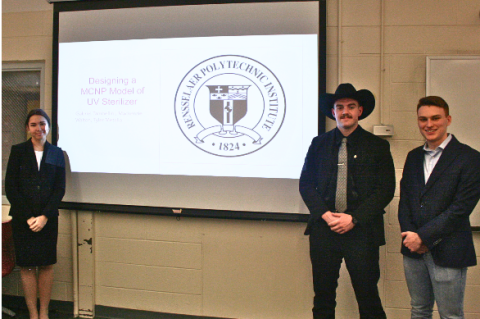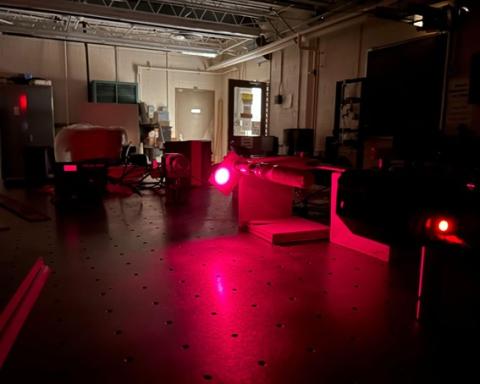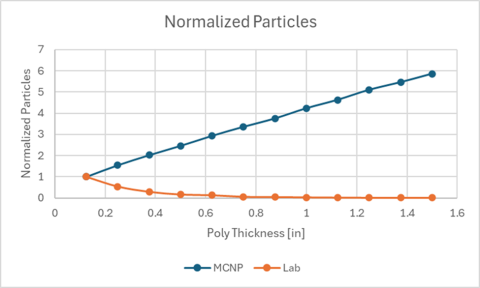Amid the ongoing COVID-19 pandemic, there is a pressing need to explore more effective sterilization methods for personal protective equipment (PPE), particularly N95 masks. Traditional techniques have proven insufficient to meet the increasing demand for sanitized PPE, highlighting the importance of investigating alternative solutions. In this context, the utilization of advanced computational modeling, specifically through the Monte Carlo N-Particle (MCNP) code, presents a promising avenue for enhancing sterilization efficacy.
Team: Gabriel Tambellini, Metallo Tyler, Mackenzie Walton
Project Advisor: Tom Haley

Group members
Project Motivation
Amid the ongoing COVID-19 pandemic, there is a pressing need to explore more effective sterilization methods for personal protective equipment (PPE), particularly N95 masks. Traditional techniques have proven insufficient to meet the increasing demand for sanitized PPE, highlighting the importance of investigating alternative solutions. In this context, the utilization of advanced computational modeling, specifically through the Monte Carlo N-Particle (MCNP) code, presents a promising avenue for enhancing sterilization efficacy.
The motivation behind this project stems from the imperative to develop a more effective method for sterilizing N95 masks using MCNP simulations. By delving into the intricate interactions between UV-C light and the materials constituting N95 masks, the aim is to optimize sterilization protocols and improve the overall efficacy of UV-C sterilization methods.
The project is driven by the belief that MCNP simulations can provide valuable insights into the energy transfer and deposition from UV-C photons within N95 mask materials. Through a refined understanding of these processes, tailored sterilization strategies can be developed to maximize effectiveness while minimizing potential risks associated with traditional methods.
Ultimately, the goal is to contribute to the advancement of robust and reliable sterilization techniques for N95 masks, thereby enhancing the safety and well-being of frontline healthcare workers and the broader community. By leveraging computational modeling, the project seeks to address the critical challenges posed by infectious disease outbreaks and PPE shortages, fostering a more resilient healthcare infrastructure in the face of future public health crises.

Photo-transmission Experiment Set-up
Project Description
The purpose of this project is to utilize a photon detection lab to validate and compare MCNP simulation results with real-world data. The primary objective is to assess the accuracy and reliability of the simulated code by conducting physical experiments and comparing the outcomes with simulation predictions.
The core methodology involves setting up experiments in the photon detection lab to measure the attenuation of light through materials commonly found in N95 masks. By precisely controlling experimental parameters such as material thickness and beam intensity, conditions relevant to sterilization processes are replicated.
Simultaneously, MCNP simulations will be run to predict the attenuation of light through the same materials under identical conditions. By comparing the experimental data with simulation predictions, the accuracy of the simulated code in accurately modeling UV-C sterilization processes can be evaluated.
The experimental validation serves as a crucial step in verifying the efficacy of the simulation approach. Discrepancies between experimental and simulated results will be analyzed to identify areas for improvement and refinement in the simulation model.
Ultimately, the integration of experimental validation with computational modeling enhances the robustness of the approach and contributes to the development of more accurate and reliable UV-C sterilization techniques for N95 masks. Through this project, the aim is to advance the understanding and application of computational modeling in optimizing sterilization processes, thereby enhancing the safety and efficacy of PPE sterilization in healthcare settings.

Normalized Particles very Polypropylene Sheet Thickness
Results and Accomplishments
Once compiling the experimental intensity transmission and the MCNP flux and dose data we were able to draw several conclusions. As seen in the figure below the normalized flux compared to the transmission does not match well. The normalized intensity decreases at an exponential rate, which would be expected from classical physics. However interestingly the flux for the MCNP simulation, which is almost 90% accurate to the lab setup, went up as thickness increased. This result verifies the use of the electron-photon-relaxation cross section data utilized in MCNP6.3.0. The photocell used to collect intensity of the beam in the laboratory has a work function that only produces a signal for a certain energy photon. However, our code, the cutoff was 1eV which ranges outside the visible light spectrum. The phenomenon causing this increase in flux is very likely Doppler production of N-Photons. Instead of the classic photoelectric effect, the red-light spectrum photons bypass the electron shell and excite the nuclear causing the subsequent release of several N-photons. Unfortunately, this result prevents us from having the ability to verify our dose rates and continue to build an analytical model of a UV sterilizer.
The greatest accomplishment from our project is the verification MCNP6.3.0 can qualitatively accurately reproduce the physical phenomenon at the visible light spectrum. Our laboratory design should be improved to use a plane source producing ultraviolet spectrum photons. With this new detector setup, a verification of the quantitative accuracy of the ultraviolet spectrum MCNP model could be tested. Once these results are verified, future engineers could continue to build a database of the radiation transport of ultraviolet photons for sterilization.